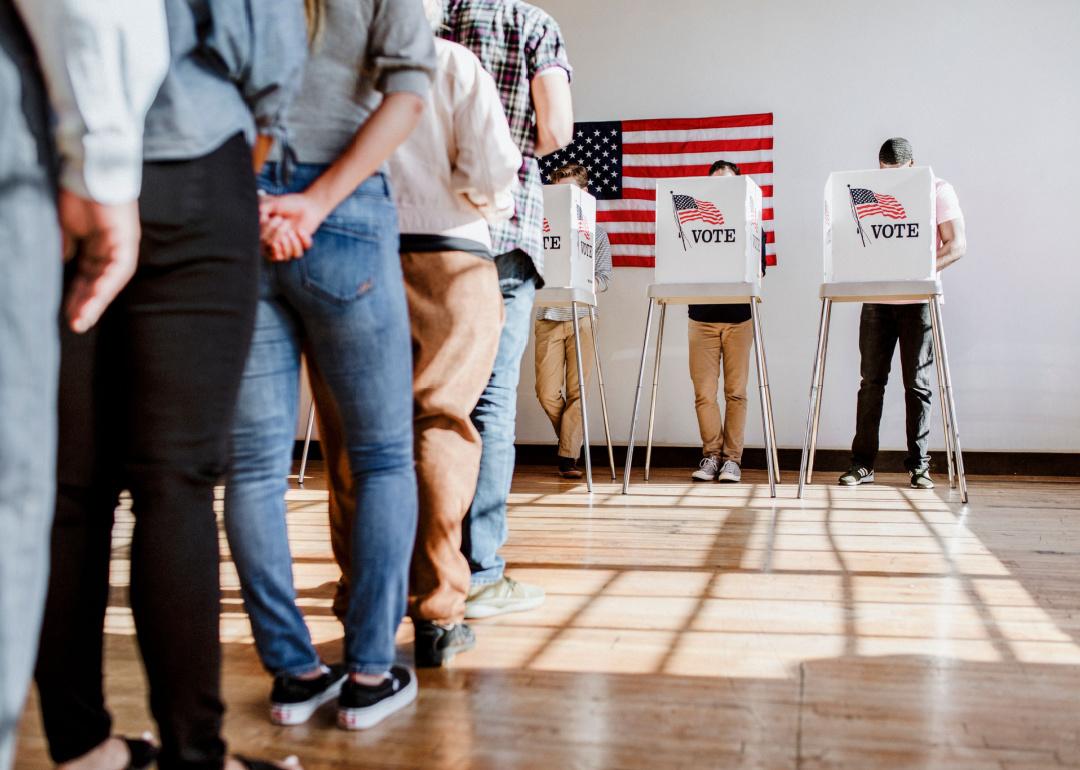
4.4 million votes: See the demographics of Wisconsin's voting population
4.4 million votes: See the demographics of Wisconsin's voting population
In 2020, 158.4 million citizens—almost two-thirds of estimated eligible voters—voted in the presidential elections, according to the Pew Research Center. The number represented a higher than average turnout, with people voting in numbers not seen since 1980 and possibly well before.
Stacker compiled voter demographics for each state and Washington, D.C., using the 2019 U.S. Census Bureau's American Community Survey (released in September 2020). Each slide shows the state's voting-eligible population (citizens who are 18 or older) and the breakdown of that population by sex, age, race, and education. Economic statistics are not included because the American Community Survey does not account for COVID-19, which affected unemployment, poverty, and medical insurance status for millions of Americans. In order to avoid making any assumptions about the data or the participants of the American Community Survey, Stacker used the exact wording of the "race" and "sex" framework that was provided in the census data.
Keep reading to see the voter demographics of your state.
Wisconsin by the numbers
- Voting-eligible population: 4,412,888
- Breakdown by sex: 49.2% male, 50.8% female
- Breakdown by age: 20.0% 18-29 years old, 23.1% 30-44 years old, 34.1% 45-64 years old, 22.9% 65+ years old
- Breakdown by race: 88.7% White, 5.9% Black or African American, 1.9% Asian, 4.3% Hispanic or Latino, 0.0% Native American or Alaska Native, 0.0% Native Hawaiian or Pacific Islander, 1.4% two or more races
- Breakdown by education: 1.9% less than high school education, 5.1% some high school (no diploma), 31.0% high school graduate or equivalency, 22.6% some college (no degree), 10.4% associate's degree, 19.7% bachelor's degree, 9.4% graduate or professional degree
A notable swing state with 10 electoral votes, Wisconsin plays an essential role in the presidential election, based on the 2016 results. The Badger State was relatively undecided four years ago; it only preferred the GOP ticket over the Democratic one by less than 1%. Including the 2016 election, Wisconsin has chosen the successful president 76.7% of the time.
By percentage, voters aged 45–64 are the highest in every state, with registered voters over the age of 45 comprising more than half the country's population. Older voters also trend toward turning out to vote at a higher rate and played a significant role in former President Donald Trump's 2016 victory in Florida.
Along racial lines, Black or African American voters in Louisiana and Georgia comprise more than 30% of the state's registered voters. California and Texas—which award the most electoral votes at 55 and 38, respectively—boast the highest numbers of Latino voters. On the other end of the spectrum, West Virginia and Maine boast the highest percentage of white voters. A number of states had already seen record voter turnouts, with 16 seeing more than half of its registered voters casting a ballot before Election Day.
Continue reading for a glimpse into the voter demographics of neighboring states.
Illinois
- Voting-eligible population: 9,088,036
- Breakdown by sex: 48.3% male, 51.7% female
- Breakdown by age: 20.9% 18-29 years old, 24.2% 30-44 years old, 33.3% 45-64 years old, 21.7% 65+ years old
- Breakdown by race: 75.0% White, 14.7% Black or African American, 4.4% Asian, 12.2% Hispanic or Latino, 0.2% Native American or Alaska Native, 0.0% Native Hawaiian or Pacific Islander, 1.9% two or more races
- Breakdown by education: 2.8% less than high school education, 5.9% some high school (no diploma), 26.3% high school graduate or equivalency, 22.9% some college (no degree), 8.3% associate's degree, 21.2% bachelor's degree, 12.5% graduate or professional degree
With one of the higher voting-eligible populations, Illinois citizens account for 20 electoral votes, making the Land of Lincoln extremely influential in any presidential election. State voters have chosen the winning commander in chief 83.33% of the time since they first cast ballots in 1900.
Iowa
- Voting-eligible population: 2,348,787
- Breakdown by sex: 49.1% male, 50.9% female
- Breakdown by age: 20.9% 18-29 years old, 23.4% 30-44 years old, 32.3% 45-64 years old, 23.4% 65+ years old
- Breakdown by race: 92.9% White, 3.2% Black or African American, 1.5% Asian, 3.8% Hispanic or Latino, 0.0% Native American or Alaska Native, 0.0% Native Hawaiian or Pacific Islander, 1.4% two or more races
- Breakdown by education: 2.0% less than high school education, 4.9% some high school (no diploma), 31.0% high school graduate or equivalency, 23.7% some college (no degree), 11.5% associate's degree, 18.8% bachelor's degree, 8.2% graduate or professional degree
Since the election of Democrat Jimmy Carter in 1976, "Iowa has remained a crucial proving ground for nearly every presidential candidate," according to Brynn Holland in a History.com article. Though awarding only six electoral votes, the Hawkeye State has significant influence during election season, fluctuating from a swing state to a region of "pivot counties," or areas that voted for Barack Obama twice followed by Donald Trump in 2016.



